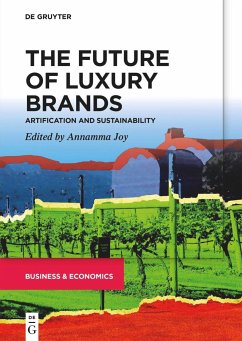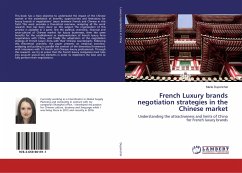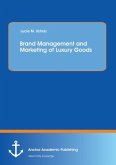The Future of Luxury Brands
Artification and Sustainability
Herausgegeben:Joy, Annamma
The Future of Luxury Brands
Artification and Sustainability
Herausgegeben:Joy, Annamma
- Broschiertes Buch
- Merkliste
- Auf die Merkliste
- Bewerten Bewerten
- Teilen
- Produkt teilen
- Produkterinnerung
- Produkterinnerung
The concepts of artification and sustainability are now both at the heart of luxury brand marketing strategies; artification as an ongoing process of transformation in the world of art and sustainability as an indispensable response to the issues of our times. The Future of Luxury Brands examines three interrelated luxury-marketing segments-the art world, fashion and fine wines including hospitality services-through the dual lenses of sustainability and artification.
From safeguarding human and natural resources to upholding labor rights and protecting the environment, sustainability has…mehr
Andere Kunden interessierten sich auch für
![Strategic Planning for Public Relations Strategic Planning for Public Relations]() Tricia Hansen-HornStrategic Planning for Public Relations41,85 €
Tricia Hansen-HornStrategic Planning for Public Relations41,85 €![Strategic Planning for Public Relations Strategic Planning for Public Relations]() Tricia Hansen-HornStrategic Planning for Public Relations166,10 €
Tricia Hansen-HornStrategic Planning for Public Relations166,10 €![French Luxury brands negotiation strategies in the Chinese market French Luxury brands negotiation strategies in the Chinese market]() Marie DuponchelFrench Luxury brands negotiation strategies in the Chinese market46,99 €
Marie DuponchelFrench Luxury brands negotiation strategies in the Chinese market46,99 €![Brand Management and Marketing of Luxury Goods Brand Management and Marketing of Luxury Goods]() Lucie ScholzBrand Management and Marketing of Luxury Goods54,99 €
Lucie ScholzBrand Management and Marketing of Luxury Goods54,99 €![Lessons From The World's Strongest Brands : Sales and Marketing Lessons From The World's Strongest Brands : Sales and Marketing]() Morteza KohansalLessons From The World's Strongest Brands : Sales and Marketing58,99 €
Morteza KohansalLessons From The World's Strongest Brands : Sales and Marketing58,99 €![The Effects of Premium Private Label Brands on Retailers' Store Image The Effects of Premium Private Label Brands on Retailers' Store Image]() Mandy Yu Man TamThe Effects of Premium Private Label Brands on Retailers' Store Image21,99 €
Mandy Yu Man TamThe Effects of Premium Private Label Brands on Retailers' Store Image21,99 €![Have luxury brands integrated animal ethics in 2017? Have luxury brands integrated animal ethics in 2017?]() Renata RépasHave luxury brands integrated animal ethics in 2017?28,99 €
Renata RépasHave luxury brands integrated animal ethics in 2017?28,99 €-
-
-
The concepts of artification and sustainability are now both at the heart of luxury brand marketing strategies; artification as an ongoing process of transformation in the world of art and sustainability as an indispensable response to the issues of our times. The Future of Luxury Brands examines three interrelated luxury-marketing segments-the art world, fashion and fine wines including hospitality services-through the dual lenses of sustainability and artification.
From safeguarding human and natural resources to upholding labor rights and protecting the environment, sustainability has taken center stage in consumer consciousness, embodying both moral authority and sound business practices. At the same time, artification-the process by which non-art is reconceived as art-applies the cachet of art to business, affording commercial products the sacred status accorded to works of art. When commercial products enter the realm of aesthetic creation, artification and consumer engagement inevitably increases.
This pioneering book examining artification and sustainability as strategic pillars of marketing strategies in the luxury industry will be essential reading for practitioners working in luxury product companies, as also students of luxury brand marketing.
Hinweis: Dieser Artikel kann nur an eine deutsche Lieferadresse ausgeliefert werden.
From safeguarding human and natural resources to upholding labor rights and protecting the environment, sustainability has taken center stage in consumer consciousness, embodying both moral authority and sound business practices. At the same time, artification-the process by which non-art is reconceived as art-applies the cachet of art to business, affording commercial products the sacred status accorded to works of art. When commercial products enter the realm of aesthetic creation, artification and consumer engagement inevitably increases.
This pioneering book examining artification and sustainability as strategic pillars of marketing strategies in the luxury industry will be essential reading for practitioners working in luxury product companies, as also students of luxury brand marketing.
Hinweis: Dieser Artikel kann nur an eine deutsche Lieferadresse ausgeliefert werden.
Produktdetails
- Produktdetails
- Verlag: De Gruyter
- 1. Auflage
- Seitenzahl: 312
- Erscheinungstermin: 21. Februar 2022
- Englisch
- Abmessung: 240mm x 170mm x 20mm
- Gewicht: 525g
- ISBN-13: 9783110737615
- ISBN-10: 3110737612
- Artikelnr.: 62862909
- Herstellerkennzeichnung Die Herstellerinformationen sind derzeit nicht verfügbar.
- Verlag: De Gruyter
- 1. Auflage
- Seitenzahl: 312
- Erscheinungstermin: 21. Februar 2022
- Englisch
- Abmessung: 240mm x 170mm x 20mm
- Gewicht: 525g
- ISBN-13: 9783110737615
- ISBN-10: 3110737612
- Artikelnr.: 62862909
- Herstellerkennzeichnung Die Herstellerinformationen sind derzeit nicht verfügbar.
Annamma Joy is Professor of Marketing on the Faculty of Management at the University of British Columbia (Canada)
Introduction
The introduction provides an overview of the book's themes of artification and sustainability in relation to luxury brands, including brief discussions of each of our four focal industries: the art world, fashion, fine wines, and hospitality. The introduction sets out the book's organizational structure, and the multiple ways in which each chapter reflects the overall agenda.
Part 1
1. The Art World: An introduction to the art world, encompassing the art market, art auctions, and issues relating to artists of color and their representation in art galleries and museums. The pressing need for implementing diversity in the employees and trustees of museums in the western world is discussed. Who decides who is deserving of exhibitions, and who meets the definition of 'artist'? Social sustainability is most relevant to the art world and market. [one of the curators of the Museum of anthropology, UBC Vancouver.]
2. Works of Art Vs. Luxury Goods: This chapter investigates the ever-increasing overlap between art and luxury goods: both reflect artisanship and an artist's or designer's personal vision; both confer a sense of personal refinement and status; and both offer ongoing aesthetic pleasure. Additionally, there is a discussion of the meaning of connection through art with the artist, and with fellow purchasers of that artist's work, as well as the elevated sense of self derived from entering an exclusive 'club', in a sense, of those who enjoy such a connection. [Russ Belk]
3. Partnerships Between Luxury Brands and Artists: This chapter considers the often-lucrative partnerships between artists and luxury brands, to the benefit of both parties [e.g., Elsa Peretti and Tiffany, who have enjoyed an ongoing arrangement since the early 1970s, in which Peretti-branded products are sold exclusively through Tiffany). [M. Masi]
4. Burning Man and Art: This chapter discusses the implications of the Burning Man festival for the art world: what is the meaning of art designed specifically to be ephemeral (i.e., the massive effigy that is ritually sacrificed in flames at the close of the gathering), and of art as a means of human bonding, in which individuals find community in isolation from normative culture through the medium of art. The chapter further raises the inherent unsustainability of a form of art based on fire, which releases carbon dioxide into the atmosphere. [John Sherry]
5. Artists as Brands: When an artist becomes celebrated worldwide, often through their alliances with luxury brands, their name can itself transform into a brand, as has occurred with such celebrity artists as Warhol, Murakami, Koons and Kaws. An artists name becomes its own logo, serving as an imprimatur of value and quality. [Jonathan Schroeder]
PART 2
Discussion of luxury brands that incorporate sustainability principles into their brand narrative and manufacturing processes and supply chains; and of the artification process, through which non-art objects become art.
6. The Artification of Luxury Brand Product Lines: This chapter considers the case of Louis Vuitton and the incorporation of art within its core identity, and charts its deliberate strategy of displaying actual works of art alongside its own luxury goods, resulting in the artification of the latter, aided by museum-level displays and adroitly theatrical use of lighting and other retail atmospherics. [Dion]
7. Street wear and Street Art: This chapter focuses on the artification process that formally began with graffiti emerging as an art movement and which now spans both the art world and luxury fashion. [Stefania Borghini and Luca Visconti]
8. Diamonds As Signifiers of Eco-Consciousness: This chapter examines sustainability in the diamond industry, as embodied by Canadian diamonds, which are mined and used in jewellery manufacture via sustainable methods from mine to store. [Linda Armano and Joy]
9. The Consumer Perspective on Sustainable Luxury: An investigation of consumer appreciation of sustainable luxury brands, including discussion of sustainability as a new and key element of luxury. [Antonella Caru or Julien Cayla)
Part 3
Luxury Hospitality Services: This short introduction considers luxury hospitality services, including hotels, resorts, and the like, that employ both sustainability and artification as marketing strategies, an essential component of their brands, and as an affirmation of a truly luxurious lifestyle.
10. Artification in Hospitality: The role of art as being emblematic of the brand in hospitality services, with discussion of this new trend in hotels and resorts appealing to guests with sophisticated interests. [Kathy La Tour]
PART 4
Fine Wines, Sustainably Produced: This section discusses fine wines, focused on sustainability throughout the discrete stages of production, from vine to store [
11. Terroir and Sustainability in the Wine Industries of Bordeaux and Burgundy: This chapter considers Terroir (the separate geographical elements of specific locations that in combination result in a wine's specific flavors, such as soil, shade, climate, and sunlight) and sustainability in the fine wines of Bordeaux and Burgundy. [Steve Charters, Dijon University and or/de Mossier]
12. Art and Architecture in Wineries: This chapter assesses how wineries set the tone for their atmospherics through exterior and interior design, the impact of those atmospherics on visitors, and the commercial power of art on wine labels over time. [Joy]
13. Unesco Heritage sites and Terroir: A consideration of Unesco World Heritage sites and fine wines, including discussion of Unesco's role in underscoring the impact of terroir on a wine's desirability and premium price. [Gabriele Troilo and Joy]
The introduction provides an overview of the book's themes of artification and sustainability in relation to luxury brands, including brief discussions of each of our four focal industries: the art world, fashion, fine wines, and hospitality. The introduction sets out the book's organizational structure, and the multiple ways in which each chapter reflects the overall agenda.
Part 1
1. The Art World: An introduction to the art world, encompassing the art market, art auctions, and issues relating to artists of color and their representation in art galleries and museums. The pressing need for implementing diversity in the employees and trustees of museums in the western world is discussed. Who decides who is deserving of exhibitions, and who meets the definition of 'artist'? Social sustainability is most relevant to the art world and market. [one of the curators of the Museum of anthropology, UBC Vancouver.]
2. Works of Art Vs. Luxury Goods: This chapter investigates the ever-increasing overlap between art and luxury goods: both reflect artisanship and an artist's or designer's personal vision; both confer a sense of personal refinement and status; and both offer ongoing aesthetic pleasure. Additionally, there is a discussion of the meaning of connection through art with the artist, and with fellow purchasers of that artist's work, as well as the elevated sense of self derived from entering an exclusive 'club', in a sense, of those who enjoy such a connection. [Russ Belk]
3. Partnerships Between Luxury Brands and Artists: This chapter considers the often-lucrative partnerships between artists and luxury brands, to the benefit of both parties [e.g., Elsa Peretti and Tiffany, who have enjoyed an ongoing arrangement since the early 1970s, in which Peretti-branded products are sold exclusively through Tiffany). [M. Masi]
4. Burning Man and Art: This chapter discusses the implications of the Burning Man festival for the art world: what is the meaning of art designed specifically to be ephemeral (i.e., the massive effigy that is ritually sacrificed in flames at the close of the gathering), and of art as a means of human bonding, in which individuals find community in isolation from normative culture through the medium of art. The chapter further raises the inherent unsustainability of a form of art based on fire, which releases carbon dioxide into the atmosphere. [John Sherry]
5. Artists as Brands: When an artist becomes celebrated worldwide, often through their alliances with luxury brands, their name can itself transform into a brand, as has occurred with such celebrity artists as Warhol, Murakami, Koons and Kaws. An artists name becomes its own logo, serving as an imprimatur of value and quality. [Jonathan Schroeder]
PART 2
Discussion of luxury brands that incorporate sustainability principles into their brand narrative and manufacturing processes and supply chains; and of the artification process, through which non-art objects become art.
6. The Artification of Luxury Brand Product Lines: This chapter considers the case of Louis Vuitton and the incorporation of art within its core identity, and charts its deliberate strategy of displaying actual works of art alongside its own luxury goods, resulting in the artification of the latter, aided by museum-level displays and adroitly theatrical use of lighting and other retail atmospherics. [Dion]
7. Street wear and Street Art: This chapter focuses on the artification process that formally began with graffiti emerging as an art movement and which now spans both the art world and luxury fashion. [Stefania Borghini and Luca Visconti]
8. Diamonds As Signifiers of Eco-Consciousness: This chapter examines sustainability in the diamond industry, as embodied by Canadian diamonds, which are mined and used in jewellery manufacture via sustainable methods from mine to store. [Linda Armano and Joy]
9. The Consumer Perspective on Sustainable Luxury: An investigation of consumer appreciation of sustainable luxury brands, including discussion of sustainability as a new and key element of luxury. [Antonella Caru or Julien Cayla)
Part 3
Luxury Hospitality Services: This short introduction considers luxury hospitality services, including hotels, resorts, and the like, that employ both sustainability and artification as marketing strategies, an essential component of their brands, and as an affirmation of a truly luxurious lifestyle.
10. Artification in Hospitality: The role of art as being emblematic of the brand in hospitality services, with discussion of this new trend in hotels and resorts appealing to guests with sophisticated interests. [Kathy La Tour]
PART 4
Fine Wines, Sustainably Produced: This section discusses fine wines, focused on sustainability throughout the discrete stages of production, from vine to store [
11. Terroir and Sustainability in the Wine Industries of Bordeaux and Burgundy: This chapter considers Terroir (the separate geographical elements of specific locations that in combination result in a wine's specific flavors, such as soil, shade, climate, and sunlight) and sustainability in the fine wines of Bordeaux and Burgundy. [Steve Charters, Dijon University and or/de Mossier]
12. Art and Architecture in Wineries: This chapter assesses how wineries set the tone for their atmospherics through exterior and interior design, the impact of those atmospherics on visitors, and the commercial power of art on wine labels over time. [Joy]
13. Unesco Heritage sites and Terroir: A consideration of Unesco World Heritage sites and fine wines, including discussion of Unesco's role in underscoring the impact of terroir on a wine's desirability and premium price. [Gabriele Troilo and Joy]
Introduction
The introduction provides an overview of the book's themes of artification and sustainability in relation to luxury brands, including brief discussions of each of our four focal industries: the art world, fashion, fine wines, and hospitality. The introduction sets out the book's organizational structure, and the multiple ways in which each chapter reflects the overall agenda.
Part 1
1. The Art World: An introduction to the art world, encompassing the art market, art auctions, and issues relating to artists of color and their representation in art galleries and museums. The pressing need for implementing diversity in the employees and trustees of museums in the western world is discussed. Who decides who is deserving of exhibitions, and who meets the definition of 'artist'? Social sustainability is most relevant to the art world and market. [one of the curators of the Museum of anthropology, UBC Vancouver.]
2. Works of Art Vs. Luxury Goods: This chapter investigates the ever-increasing overlap between art and luxury goods: both reflect artisanship and an artist's or designer's personal vision; both confer a sense of personal refinement and status; and both offer ongoing aesthetic pleasure. Additionally, there is a discussion of the meaning of connection through art with the artist, and with fellow purchasers of that artist's work, as well as the elevated sense of self derived from entering an exclusive 'club', in a sense, of those who enjoy such a connection. [Russ Belk]
3. Partnerships Between Luxury Brands and Artists: This chapter considers the often-lucrative partnerships between artists and luxury brands, to the benefit of both parties [e.g., Elsa Peretti and Tiffany, who have enjoyed an ongoing arrangement since the early 1970s, in which Peretti-branded products are sold exclusively through Tiffany). [M. Masi]
4. Burning Man and Art: This chapter discusses the implications of the Burning Man festival for the art world: what is the meaning of art designed specifically to be ephemeral (i.e., the massive effigy that is ritually sacrificed in flames at the close of the gathering), and of art as a means of human bonding, in which individuals find community in isolation from normative culture through the medium of art. The chapter further raises the inherent unsustainability of a form of art based on fire, which releases carbon dioxide into the atmosphere. [John Sherry]
5. Artists as Brands: When an artist becomes celebrated worldwide, often through their alliances with luxury brands, their name can itself transform into a brand, as has occurred with such celebrity artists as Warhol, Murakami, Koons and Kaws. An artists name becomes its own logo, serving as an imprimatur of value and quality. [Jonathan Schroeder]
PART 2
Discussion of luxury brands that incorporate sustainability principles into their brand narrative and manufacturing processes and supply chains; and of the artification process, through which non-art objects become art.
6. The Artification of Luxury Brand Product Lines: This chapter considers the case of Louis Vuitton and the incorporation of art within its core identity, and charts its deliberate strategy of displaying actual works of art alongside its own luxury goods, resulting in the artification of the latter, aided by museum-level displays and adroitly theatrical use of lighting and other retail atmospherics. [Dion]
7. Street wear and Street Art: This chapter focuses on the artification process that formally began with graffiti emerging as an art movement and which now spans both the art world and luxury fashion. [Stefania Borghini and Luca Visconti]
8. Diamonds As Signifiers of Eco-Consciousness: This chapter examines sustainability in the diamond industry, as embodied by Canadian diamonds, which are mined and used in jewellery manufacture via sustainable methods from mine to store. [Linda Armano and Joy]
9. The Consumer Perspective on Sustainable Luxury: An investigation of consumer appreciation of sustainable luxury brands, including discussion of sustainability as a new and key element of luxury. [Antonella Caru or Julien Cayla)
Part 3
Luxury Hospitality Services: This short introduction considers luxury hospitality services, including hotels, resorts, and the like, that employ both sustainability and artification as marketing strategies, an essential component of their brands, and as an affirmation of a truly luxurious lifestyle.
10. Artification in Hospitality: The role of art as being emblematic of the brand in hospitality services, with discussion of this new trend in hotels and resorts appealing to guests with sophisticated interests. [Kathy La Tour]
PART 4
Fine Wines, Sustainably Produced: This section discusses fine wines, focused on sustainability throughout the discrete stages of production, from vine to store [
11. Terroir and Sustainability in the Wine Industries of Bordeaux and Burgundy: This chapter considers Terroir (the separate geographical elements of specific locations that in combination result in a wine's specific flavors, such as soil, shade, climate, and sunlight) and sustainability in the fine wines of Bordeaux and Burgundy. [Steve Charters, Dijon University and or/de Mossier]
12. Art and Architecture in Wineries: This chapter assesses how wineries set the tone for their atmospherics through exterior and interior design, the impact of those atmospherics on visitors, and the commercial power of art on wine labels over time. [Joy]
13. Unesco Heritage sites and Terroir: A consideration of Unesco World Heritage sites and fine wines, including discussion of Unesco's role in underscoring the impact of terroir on a wine's desirability and premium price. [Gabriele Troilo and Joy]
The introduction provides an overview of the book's themes of artification and sustainability in relation to luxury brands, including brief discussions of each of our four focal industries: the art world, fashion, fine wines, and hospitality. The introduction sets out the book's organizational structure, and the multiple ways in which each chapter reflects the overall agenda.
Part 1
1. The Art World: An introduction to the art world, encompassing the art market, art auctions, and issues relating to artists of color and their representation in art galleries and museums. The pressing need for implementing diversity in the employees and trustees of museums in the western world is discussed. Who decides who is deserving of exhibitions, and who meets the definition of 'artist'? Social sustainability is most relevant to the art world and market. [one of the curators of the Museum of anthropology, UBC Vancouver.]
2. Works of Art Vs. Luxury Goods: This chapter investigates the ever-increasing overlap between art and luxury goods: both reflect artisanship and an artist's or designer's personal vision; both confer a sense of personal refinement and status; and both offer ongoing aesthetic pleasure. Additionally, there is a discussion of the meaning of connection through art with the artist, and with fellow purchasers of that artist's work, as well as the elevated sense of self derived from entering an exclusive 'club', in a sense, of those who enjoy such a connection. [Russ Belk]
3. Partnerships Between Luxury Brands and Artists: This chapter considers the often-lucrative partnerships between artists and luxury brands, to the benefit of both parties [e.g., Elsa Peretti and Tiffany, who have enjoyed an ongoing arrangement since the early 1970s, in which Peretti-branded products are sold exclusively through Tiffany). [M. Masi]
4. Burning Man and Art: This chapter discusses the implications of the Burning Man festival for the art world: what is the meaning of art designed specifically to be ephemeral (i.e., the massive effigy that is ritually sacrificed in flames at the close of the gathering), and of art as a means of human bonding, in which individuals find community in isolation from normative culture through the medium of art. The chapter further raises the inherent unsustainability of a form of art based on fire, which releases carbon dioxide into the atmosphere. [John Sherry]
5. Artists as Brands: When an artist becomes celebrated worldwide, often through their alliances with luxury brands, their name can itself transform into a brand, as has occurred with such celebrity artists as Warhol, Murakami, Koons and Kaws. An artists name becomes its own logo, serving as an imprimatur of value and quality. [Jonathan Schroeder]
PART 2
Discussion of luxury brands that incorporate sustainability principles into their brand narrative and manufacturing processes and supply chains; and of the artification process, through which non-art objects become art.
6. The Artification of Luxury Brand Product Lines: This chapter considers the case of Louis Vuitton and the incorporation of art within its core identity, and charts its deliberate strategy of displaying actual works of art alongside its own luxury goods, resulting in the artification of the latter, aided by museum-level displays and adroitly theatrical use of lighting and other retail atmospherics. [Dion]
7. Street wear and Street Art: This chapter focuses on the artification process that formally began with graffiti emerging as an art movement and which now spans both the art world and luxury fashion. [Stefania Borghini and Luca Visconti]
8. Diamonds As Signifiers of Eco-Consciousness: This chapter examines sustainability in the diamond industry, as embodied by Canadian diamonds, which are mined and used in jewellery manufacture via sustainable methods from mine to store. [Linda Armano and Joy]
9. The Consumer Perspective on Sustainable Luxury: An investigation of consumer appreciation of sustainable luxury brands, including discussion of sustainability as a new and key element of luxury. [Antonella Caru or Julien Cayla)
Part 3
Luxury Hospitality Services: This short introduction considers luxury hospitality services, including hotels, resorts, and the like, that employ both sustainability and artification as marketing strategies, an essential component of their brands, and as an affirmation of a truly luxurious lifestyle.
10. Artification in Hospitality: The role of art as being emblematic of the brand in hospitality services, with discussion of this new trend in hotels and resorts appealing to guests with sophisticated interests. [Kathy La Tour]
PART 4
Fine Wines, Sustainably Produced: This section discusses fine wines, focused on sustainability throughout the discrete stages of production, from vine to store [
11. Terroir and Sustainability in the Wine Industries of Bordeaux and Burgundy: This chapter considers Terroir (the separate geographical elements of specific locations that in combination result in a wine's specific flavors, such as soil, shade, climate, and sunlight) and sustainability in the fine wines of Bordeaux and Burgundy. [Steve Charters, Dijon University and or/de Mossier]
12. Art and Architecture in Wineries: This chapter assesses how wineries set the tone for their atmospherics through exterior and interior design, the impact of those atmospherics on visitors, and the commercial power of art on wine labels over time. [Joy]
13. Unesco Heritage sites and Terroir: A consideration of Unesco World Heritage sites and fine wines, including discussion of Unesco's role in underscoring the impact of terroir on a wine's desirability and premium price. [Gabriele Troilo and Joy]








